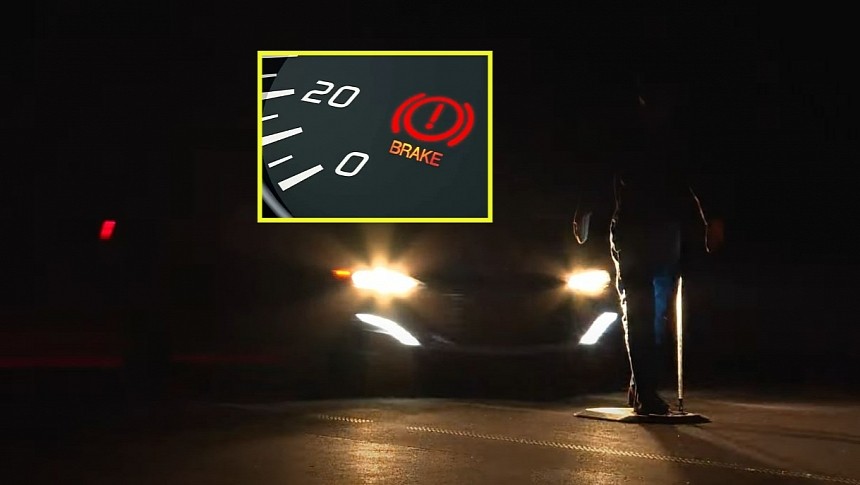The National Highway Traffic Safety Administration (NHTSA) announced that it intends to make Automatic Emergency Braking (AEB) part of the standard equipment on all vehicles with a gross vehicle weight of 10,000 lb (4,536 kg) or less. Besides this, cars and light trucks must be able to recognize pedestrians even at night.
Four months ago, the Governors Highway Safety Association (GHSA) showed that annual US pedestrian fatalities returned to the 1982 level. It underlined the regression in this respect by showing that over 7,000 Americans lost their lives in 2021, despite vehicles becoming more intelligent and safer.
The preliminary data for 2022 isn't looking good, either. The same source says that pedestrian deaths surged by 5% in the first half of last year and blamed dangerous driving, inadequate infrastructure, and larger vehicles for leading to such deadly conditions. Approximately 19 pedestrians lose their lives every day in America. This is worrying for drivers, people who like or need to walk often, automakers, and public office incumbents.
In March, Transportation Secretary Pete Buttigieg told state officials to genuinely consider the safety of pedestrians and cyclists when announcing new road projects. But besides urging the right people to take action, Buttigieg also made the NHTSA create a new rule that forces all automakers to enhance their vehicles' standard safety systems.
Thus, the proposed rule forces manufacturers to make the AEB standard on all passenger cars and light trucks. Moreover, new models should be able to stop when a pedestrian is detected – even at night.
If implemented according to the current proposal, cars and light trucks should be able to stop and avoid contact with a vehicle or a human in front of them up to 62 mph (100 kph). That is, of course, only if the driver does not apply enough braking force. The system should also be able to complement the driver in stopping the vehicle even when they press the brake pedal but do not put enough pressure.
If adopted, the NHTSA's proposed rule will force automakers to install the comprehensive AEB system three years after the final form of the act is published.
"Just as lifesaving innovations from previous generations like seat belts and airbags have helped improve safety, requiring automatic emergency braking on cars and trucks would keep all of us safer on our roads," said Buttigieg.
Lastly, buyers shouldn't worry about cars or trucks becoming even heavier in case this change ends up being implemented industry-wide. A camera-based AEB is not complicated or expensive to implement. It could challenge brands like Subaru, which still needs to make its driver-assist technology work on manual cars.
The Notice of proposed rulemaking (NPRM) is attached below, which also contains instructions regarding the comment submitting methods.
The preliminary data for 2022 isn't looking good, either. The same source says that pedestrian deaths surged by 5% in the first half of last year and blamed dangerous driving, inadequate infrastructure, and larger vehicles for leading to such deadly conditions. Approximately 19 pedestrians lose their lives every day in America. This is worrying for drivers, people who like or need to walk often, automakers, and public office incumbents.
In March, Transportation Secretary Pete Buttigieg told state officials to genuinely consider the safety of pedestrians and cyclists when announcing new road projects. But besides urging the right people to take action, Buttigieg also made the NHTSA create a new rule that forces all automakers to enhance their vehicles' standard safety systems.
Thus, the proposed rule forces manufacturers to make the AEB standard on all passenger cars and light trucks. Moreover, new models should be able to stop when a pedestrian is detected – even at night.
If implemented according to the current proposal, cars and light trucks should be able to stop and avoid contact with a vehicle or a human in front of them up to 62 mph (100 kph). That is, of course, only if the driver does not apply enough braking force. The system should also be able to complement the driver in stopping the vehicle even when they press the brake pedal but do not put enough pressure.
If adopted, the NHTSA's proposed rule will force automakers to install the comprehensive AEB system three years after the final form of the act is published.
"Just as lifesaving innovations from previous generations like seat belts and airbags have helped improve safety, requiring automatic emergency braking on cars and trucks would keep all of us safer on our roads," said Buttigieg.
Lastly, buyers shouldn't worry about cars or trucks becoming even heavier in case this change ends up being implemented industry-wide. A camera-based AEB is not complicated or expensive to implement. It could challenge brands like Subaru, which still needs to make its driver-assist technology work on manual cars.
The Notice of proposed rulemaking (NPRM) is attached below, which also contains instructions regarding the comment submitting methods.







